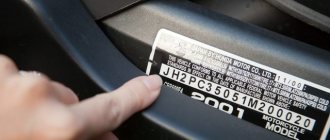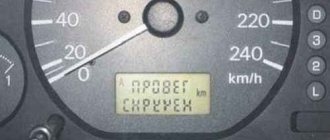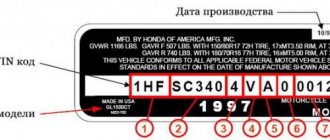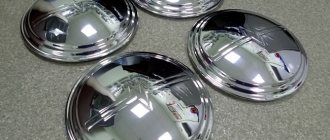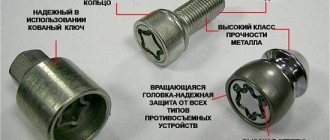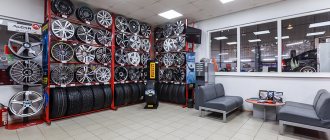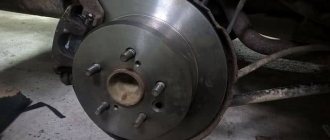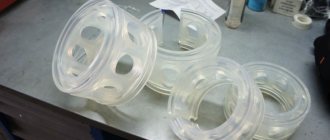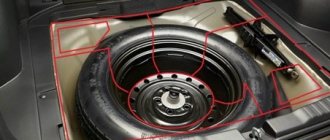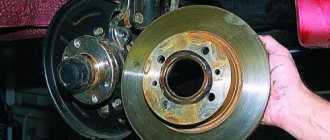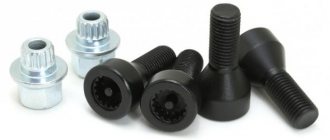The wheel disc is an important part and an integral part of any car.
This element is assigned not only the main operational function, but also an aesthetic load.
Today, the market offer is capable of satisfying almost any needs of the modern consumer, and choosing wheels for a car based only on design and price will not be difficult.
The vast majority of car enthusiasts are guided by these two components, sometimes forgetting about much more important and significant parameters for selecting wheels for a car.
Further material will help the reader understand how to choose the right wheel rims, taking into account all the most important parameters.
Well, if you don’t want to understand the material and want to simplify your life, then go to the page where you can quickly select wheels by car make.
Basic disk size. What is he like?
The basic wheel size is a certain set of wheel configurations that are put on a vehicle at a car factory in accordance with all technology conditions, the class of the car, as well as strength studies carried out by the concern’s engineers.
When leaving the factory, the car acquires the following standard characteristics of wheel rims:
- The parameters of the rim edge necessary for reliable fastening of the tire are indicated by the letter symbols J or JJ. This marking is suitable for rims of all passenger cars, regardless of make and model.
- The thickness of the rim of the product is calculated in inches with a distance of 0.5 units. The final tire size depends on it. In standard car modifications, this size is from 4 to 12 inches, which corresponds to a tire with an offset of 145-345 mm.
- The most significant value is the radius of the disk, which is determined without taking into account the edges by the diameter of the rim and is calculated in inches from 12 to 24. It is written as R12, R13... R21, R22, R23, etc. This value determines the radius of the tire, which must correspond to this parameter, as well as its profile, which depends on the configuration of the wheel arch and the technical parameters of the manufacturer.
- The factory also takes into account the range of wheel offsets required for a particular brand, that is, the disc offset value ET, which will indicate the distance from the place where the disc is attached to the hub to its inner mating plane of the disc. The greater the ET offset, the deeper the tire will be fixed under the wheel arch.
If the above indicators allow you to indicate a small spread in wheel sizes, then parameters such as the disc bolt pattern and drilling must remain the same, otherwise the rubber will not fit on the hub. So:
- The disc bolt pattern is a value that calculates the number and length of studs on the hub. Designed to fix the wheel. For example, in small cars the studs are usually made with an offset of 4*98, 4*100, that is, the disk is fixed to 4 anchors, each 98 or 100 mm long. In business class cars or SUVs, the number of fasteners ranges from 4 to 10 pieces, and their length extends to 140 mm.
- drilling (PCD) - an indicator of the disk mounting hole, thanks to which it is installed on the axle. Its dimensions range from 50 to 120 mm, depending on the make, model and class of the car.
Is it acceptable to drive on tires of different widths?
From a legal perspective, having different tires on the front and rear is not a violation. In any case, there are no direct prohibitions on the use of different tires, provided that the condition is met that the tires on the same axle must be identical. From the point of view of directional stability, if you put tires of different widths at the rear and front, the car should not pull to the side. However, there are also some peculiarities here that must be taken into account. So, during rain, if there is a strong discrepancy in the performance of the rear and front wheels, the car will definitely hold the road worse, so the discrepancy in size should not be large.
A special case is the installation of summer and winter tires at the same time - usually on single-wheel drive cars, summer tires are installed on the front, winter tires on the rear. On all-wheel drive vehicles, the weight of the front part of the vehicle is disproportionately increased, since all the important components are concentrated in the engine compartment. If you put winter tires on the front of such a car, on a slippery road it will cope perfectly with skidding in the front, but the rear will wobble noticeably, which can cause a skid and an emergency situation.
So the fact that there is no penalty for installing tires of different widths on different axles does not mean that this opportunity should be abused, since road safety is much more important than all other factors. If you do not have the physical ability to install the same tires on the back and front, and this situation often arises at the current cost of a set of tires, then we advise you to select tires whose sizes differ from those installed by the minimum amount.
Needless to say, installing different tires on the same axle is generally unacceptable, and the current fine for such a violation (500 rubles) does not in any way reflect the degree of danger to which the violating driver and other road users are exposed. And if you had no other choice, and you were stopped by a very attentive and picky traffic police officer, you can try to avoid punishment by declaring that you already punctured a tire on the road and were forced to use a spare tire with a different size. Emphasize that this happened literally a few kilometers ago, and now you are heading to the nearest service station - usually the inspector accepts this excuse.
How to determine the dimensions of cast and stamped wheels?
Each factory disk on the car is, of course, marked, and upon visual inspection you can find a line on it with the indicators listed above. If due to circumstances, for example, in case of disc wear, these parameters are not visible, then the wheel can be measured independently and its markings can be determined. You must proceed as follows:
- To determine the width of the disk, it is measured with a tape measure or a ruler, the rim of the product in millimeters, and then the resulting distance is divided by 25.4 mm to convert to inches.
- The radius of the disks is determined in a similar way, only here their diameter is measured. Some people think that the R symbol means the radius of the rim, but this is incorrect, as it is the required gap between the two distances on the rim from the center of the rim. The resulting data should be divided by 25.4 mm to obtain the result in inches.
- The greatest difficulty is in measuring the wheel offset, that is, the ET indicator. To do this, you need to remove the wheel, lay it flat on the ground, and put a wooden strip on it equal to the diameter of the metal part of the disk. Then measure the gap to the mating plane of the product in mm. Turn the wheel 180° and repeat the procedure on the reverse side. Substitute the data into the formula for finding ET = (X+Y): 2, where X is the first indicator, Y is the second indicator, and ET is the required overhang size. All results will be indicated in millimeters.
- To determine the PCD or the diameter of the central hole of the disk (DIA), the car enthusiast only needs to measure the maximum distance between the edges of the perforations, and then find the closest value using the table of deviations and correspondences. The indicator of the wheel disk holes depends on the structure of the hub for a certain brand of car.
Competent selection of tires for the car
In order to ensure maximum safety for the driver and passengers on the road, it is necessary to correctly select tires according to the make of the car. They must have appropriate parameters to ensure the full performance of all functions assigned to them. Airbags and seat belts, the ABS system are all good. However, tires continue to play the main role in traffic safety .
This structural element performs several important functions. This is not only the car’s grip on the road, but also keeps the car from skidding when turning. In addition, the tires provide instant braking.
How to decipher wheel rim parameters? Specific examples
On all original factory wheels, the car owner has access to markings that indicate the size of this product. To ensure that your actions are correct, you should familiarize yourself with some illustrative examples:
- When changing wheels to more attractive ones, the Lada owner sees the inscription on the rim 5.5J*15 ET 42 d56.1 4*98, which means: wheel rim 5.5 inches rim width, edge configuration J, not disassembled (marking “x”), radius 15 inches, wheel offset 42 mm, drilling (output hole diameter) 56.1 mm, bolt pattern for 4 studs of 98 mm each.
- The designation J depends on the class, model and weight of the car; it can be replaced by JJ, K, JK, B, P and D, which corresponds to the marking of the purchased disk.
- Also on the wheel there are Hump or H markings, for example 6.0J*17 H2 ET38 d65.1 5*112. This hump consists of special protrusions along the sides that enhance the strength of the rubber attachment to the disc. This parameter can be marked as H - single, on one wheel side, H2 - double, on both edges, or X - truncated.
- For drivers of pickup trucks, minivans and other vehicles intended for transporting cargo, the maximum load values are indicated, which are marked as follows - Max Load 2000Lb. This figure will indicate the highest load of 2000 pounds (910 kg when translated).
- An important parameter of strength is the pressure marking in the tires and on the rim, which is expressed as Max PSI 50 Cold, where the highest tire pressure should not exceed 3.5 kg per cm².
- The last thing you can find on the wheel rim is the letter SAE. TUV, ISO or Rostest, indicating that the product has passed the necessary certification after a series of tests and fully meets the requirements of international and Russian standards.
Other ways to set disk sizes
Quite often, the car owner does not strive to deviate from the disk configurations prescribed by the car manufacturer. Then he just needs to purchase rims according to the same parameters specified by the manufacturer. It is important to note that incorrectly selected product sizes often lead to rapid wear of hubs, calipers, brake systems and other suspension parts, which contributes to the waste of significant amounts of money during repairs.
The most preferable and competent choice of wheel rims for a particular car model is purchasing at a dealership from a brand distributor. For example, official automobile companies often provide wheel rims not only of their own production, but also accredited analogues.
In most large sales centers, consultants have special software installed that helps them easily determine the specified disk sizes. When you contact the center manager, who will fill in the appropriate fields in the program on the computer - brand, model and variation of the vehicle, year of manufacture, etc. data, you can get a whole list of suitable wheels that correspond to the geometric characteristics of the client’s car.
Typically, such software is associated with a warehouse system and also allows you to inform the client about the availability of goods in stock, about the brands that produce these rims, as well as about the price and appearance. Based on this information, the buyer can decide on the disc grille design, size, material, and also calculate his budget.
In this way, the client can be confident in the quality of the wheels, as well as in the correct selection of rim sizes, and, moreover, the warranty will not be removed from his vehicle. Many car owners may not be satisfied with the strict pricing policy of dealers, but the received guarantee of a long, reliable and safe service life more than justifies possible overpayments.
